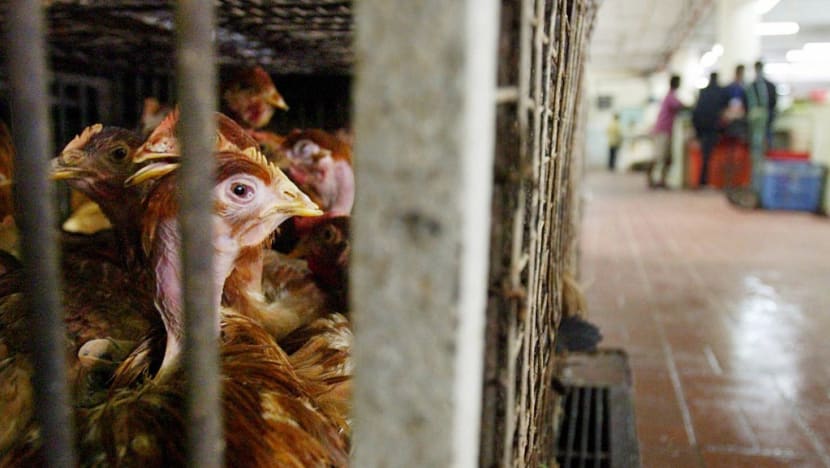Malaysia bans chicken exports: What you need to know

File photo of chickens kept in a cage waiting to be sold at a market in Kuala Lumpur. (Photo: AFP/Jimin Lai)
SINGAPORE: Malaysia announced on May 23 that it will curb the export of chickens from Jun 1 to ensure that there is sufficient supply in the domestic market.
“The government’s priority is our own people,” Prime Minister Ismail Sabri Yaakob said in a statement, adding that authorities will also investigate allegations of cartel pricing.
Here's what you need to know about Malaysia's export curbs and the potential impact of the move:
Q: Why is Malaysia imposing a ban?
Malaysian customers have complained of rising chicken prices amid a supply shortage, with some retailers resorting to rationing their sales.
According to major players in the chicken industry, factors that have affected supply include the rising costs of chicken production, disease infection and weather conditions.
These issues were raised in a meeting with Malaysia's Agriculture and Food Industries Minister on May 23.
A farmer in Johor told CNA that said one issue affecting supplies is the rising cost of chicken feed, which has reportedly gone up twice over the last month.
Q: What else is Malaysia doing to address the issue?
Apart from halting the export of up to 3.6 million chickens a month starting June, Malaysia said it will create a buffer stock of chicken and optimise existing cold storage facilities under the Ministry of Agriculture and Food Industries and agencies.
Authorities will also simplify the subsidy claims process for chicken producers and recognise overseas slaughterhouses to increase the production of the country’s chicken supply.
The approved permit for importing whole and cut chicken has been abolished, a move which is aimed at increasing food supply.
The prime minister said the government is aware of claims that cartels are controlling the price and supply, adding that authorities will investigate the allegations.
Q: How long will the export ban last?
No date has been set for resuming exports, with Malaysia saying only that the ban will last until domestic prices and production stabilise.
The supply situation has actually been going on since the start of the year, said Mr Ameer Ali Mydin, the managing director of the Mydin chain of hypermarket and retail outlets in Malaysia.
He told CNA that the chain’s weekly orders – usually amounting to about 100 tonnes for all outlets – have fallen to 40 tonnes.
Smaller retailers also reported receiving fewer supplies.
Related:
Q: How much does Singapore import from Malaysia?
Malaysia exported poultry meat worth US$18.9 million in 2020, making it the 49th largest exporter of the product in the world.
Its main export markets are Thailand, Singapore, Japan, Hong Kong and Brunei, according to the data platform Observatory of Economic Complexity.
Singapore imports about 34 per cent of its chicken supply from Malaysia, almost all of which is brought in as live chickens that are then slaughtered and chilled locally.
"The sudden announcement by Malaysia is likely going to have an adverse impact on the prices of chicken and related products in Singapore," the president of the Consumers Association of Singapore (CASE) Melvin Yong said on May 24.

Q: What's been the impact on Singapore consumers?
The day after Malaysia's announcement, some wet market stallholders said they may have to close temporarily, adding that the export ban could result in a further increase in chicken prices, driving customers away.
When CNA checked on several stalls on May 26, chicken sellers said they were facing a 20 to 70 per cent shortage. They noted that some customers have been buying more to stock up.
Chicken importers in Singapore have also expressed concerns about shifting to alternative sources on short notice.
While there may be temporary disruptions to the supply of chilled chicken, the Singapore Food Agency (SFA) said frozen chicken remains available, urging consumers to consider that option as well as other sources of meat products.
SFA said it is working with stakeholders to minimise the impact of the ban on local supply.
"For example, they will activate their supply chains to increase imports of chilled chicken from alternative sources, increase import of frozen chicken from existing non-Malaysia suppliers, or draw from their stocks of poultry," it added.
Q: Where else does Singapore get chicken from?
According to SFA, Singapore imported 214,400 tonnes of chicken in 2021.
Nearly half of the chicken imports came from Brazil. The United States accounted for 8 per cent of imports, while other countries and regions contributed 10 per cent.
Singapore also imported 52 per cent of its egg supply from Malaysia in 2021. Another 30 per cent was produced locally, while Poland provided 9 per cent.
Ten per cent was imported from other countries and regions.



















